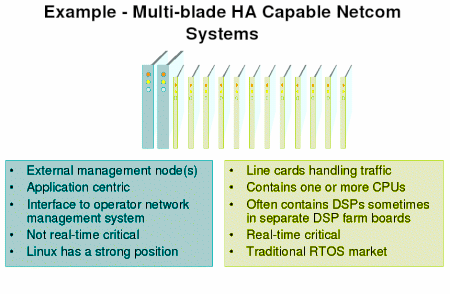SDK combines Linux with RTOS for telecom/datacom apps
Jul 28, 2004 — by LinuxDevices Staff — from the LinuxDevices Archive — 2 viewsEnea is shipping a packaged SDK (software development kit) for telecom and datacom equipment makers that includes embedded Linux, a proprietary RTOS (real-time operating system), and tools to help the two operating systems work together on complex multi-processor systems. The “Orchestra” SDK also includes a graphical IDE (integrated development environment) that works with both OSes, and a real-time… in-memory database that can run on either.
Enea first announced its intentions to distribute embedded Linux and market Linux tools in late April — six months after competitor Wind River began a similar strategic shift toward Linux.
According to Enea, Orchestra represents a complete, packaged product with everything engineers need to build powerful multi-processor telecom and datacom systems that run both Linux and Enea's OSE RTOS or OSEck for DSPs (digital signal processors). Such systems typically use a Unix-like operating system like Solaris or increasingly, Linux, in management and control systems, while a real-time OS is deployed on data and signal processing blades.

Linux is typically used on management blades (blue), in conjunction with an RTOS such as OSE that runs on processor and DSP blades (green), according to Enea
To improve the interoperability of OSE/OSEck with other operating systems, Enea offers an OSE Gateway that provides protocol-neutral message passing capabilties enabling applications to be distributed across several processor blades. Enea has long offered OSE Gateway for Solaris and other OSes and RTOSes, and announced a Linux port last April.
In addition to OSE and Linux, Orchestra includes a build of Metrowerks CodeWarrior Platform Creation Suite that can be used with both OSE and any Linux operating system (Metrowerks Linux is the version supplied with Orchestra). Metrowerks will provide second-line CodeWarrior support to Orchestra customers through a partnership with Enea.
Enea says that Orchestra's support for both Linux and OSE/OSEck lets engineers defer decisions about which subsystems will run which operating system, for greater design flexibility.
Orchestra also includes Enea's Polyhedra database, a fault-tolerant, real-time, in-memory database that can run on Linux or OSE (as well as several other OSes and RTOSes).
Availability
Orchestra is available now as an evaluation kit priced at $5,000 including a PowerQuicc I development board, or $6,000 with a PowerQuicc III development board. The evaluation kit includes services to aid evaluation.
Orchestra is also available now under a subscription model, in two versions. The $4,995 per seat Platform Development Suite targets system-level programmers, while a $9,995 per seat Applications Development Suite targets application programmers. A complete development environment requires both components, according to Enea. OSE is traditionally distributed as a royalty-bearing RTOS; however, Enea is offering an unlimited buyout licensing option that eliminates royalties. The buyout option costs $20,000 per developer seat, with some room for negotiation, Enea says.
This article was originally published on LinuxDevices.com and has been donated to the open source community by QuinStreet Inc. Please visit LinuxToday.com for up-to-date news and articles about Linux and open source.